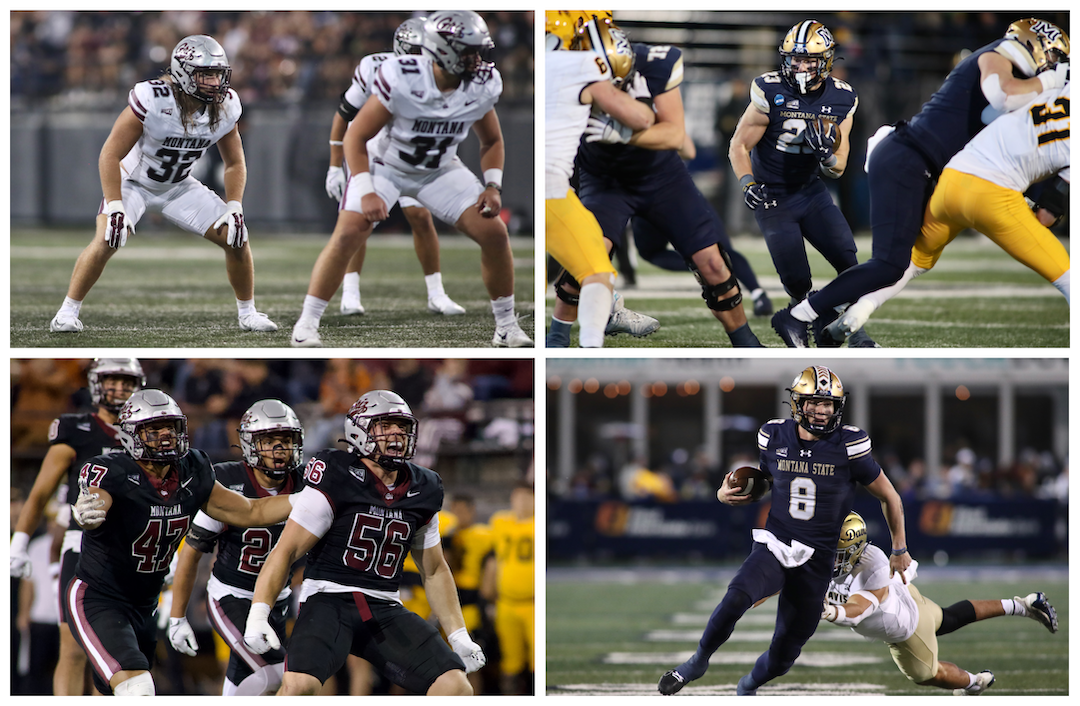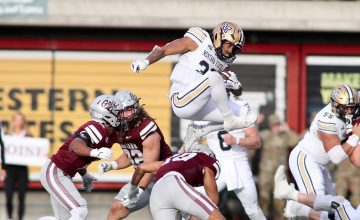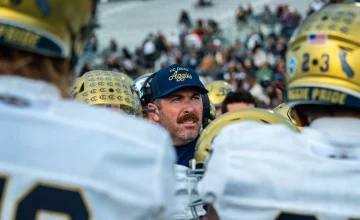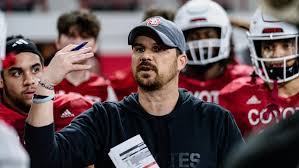Chaos versus steadiness. Ball-hawking versus ball-hoarding.
Which side will emerge on Saturday?
Montana’s 3-3-5 stack is unorthodox, chaotic and, at times, has been a kryptonite for Montana State’s vaunted spread option offense.
Entering this year’s rivalry game, Montana’s defense has a new look with an array of new faces, although the high-pressure nature and the chaos the scheme creates still exists. And Montana State’s offense experienced a wholesale change this off-season both because of the graduation of Walter Payton Award-winning quarterback Tommy Mellott and because of the departure of three offensive assistants, including former offensive coordinator Tyler Walker.
Montana leads the league in interceptions while Montana State quarterback Justin Lamson has not thrown an interception in Big Sky Conference play. Yet UM’s defense is filled with faces making their rivalry game debuts on Saturday in Missoula and Lamson has lived in Montana for less than a year.
While Montana State’s league-leading defense versus Montana’s league-leading offense is grabbing all the headlines, when the Bobcats have the ball, how will their new-look, balanced and efficient offense perform against a Griz defense that didn’t return a single starter from a year ago yet has performed well enough to have UM at 11-0 entering this year’s clash?
Geno Leonard grew up in Missoula and helped lead Sentinel to a state championship.
— Skyline Sports (@SkylineSportsMT) November 19, 2025
He plays in his last (guaranteed) rivalry game for #GrizFB against #MSUBobcatsFB on Saturday. Here's his thoughts on this weekend's Brawl. pic.twitter.com/OFdp7jQ3X0
“They are a good offense and they play well together, too,” UM fifth-year senior linebacker Geno Leonard, a Missoula native, said on Monday. “They like to run the ball and they are good at it. I think we will be ready for that. We go against one of the best offenses in the country every day at practice so I think we will be ready to go and ready to get after it.”
Montana State enters Saturday averaging more than 38 points per game. MSU has led the league in rushing every year since 2018, but that’s not the case this season because Sac State has committed to a run-first offense that has helped the Hornets average 257 rushing yards per game. Still, the Bobcats are second in the league at 232 rushing yards per contest, almost 50 more per game than third-place UC Davis.
The Bobcats have paired that with a passing game that throws for 215 yards per game. Lamson has thrown 19 touchdowns so far in his first season playing in the Big Sky.
“Defensively, they continue to pose challenges with their aggression, their alignments, their variability, all those things,” Montana State fifth-year head coach Brent Vigen said. “For us going into that environment, we are going to have to do everything we can to play as clean a game as we possibly can and certainly make it about what’s going on between the white lines. And that in itself is challenging.
“They present problems because they present a lot of pre-snap pictures. It’s organized chaos but it’s not chaos, because it’s organized. Our guys up front being on the same page consistently is important. How we communicate that when we are on offense is a big piece to it.”
When the Griz defense is at its best, it shoots gaps, confuses offensive lines with its varying pre-snap alignments and chaotic post-snap shifts while erasing opposing run games. More than once, though, Montana State has made the defense look vulnerable and unsound, particularly when Jeff Choate helped lead MSU to four straight rivalry wins over the Griz, including wins in 2018 and 2019 following Bobby Hauck’s return to lead his alma mater and the concurrent implementation of the defensive scheme Hauck learned while coaching under Rocky Long at San Diego State.
Those Choate teams would gap-scheme the Grizzlies to death, exploiting UM’s lack of run fits and instead catching UM’s players in space, running the football right down their respective throats.
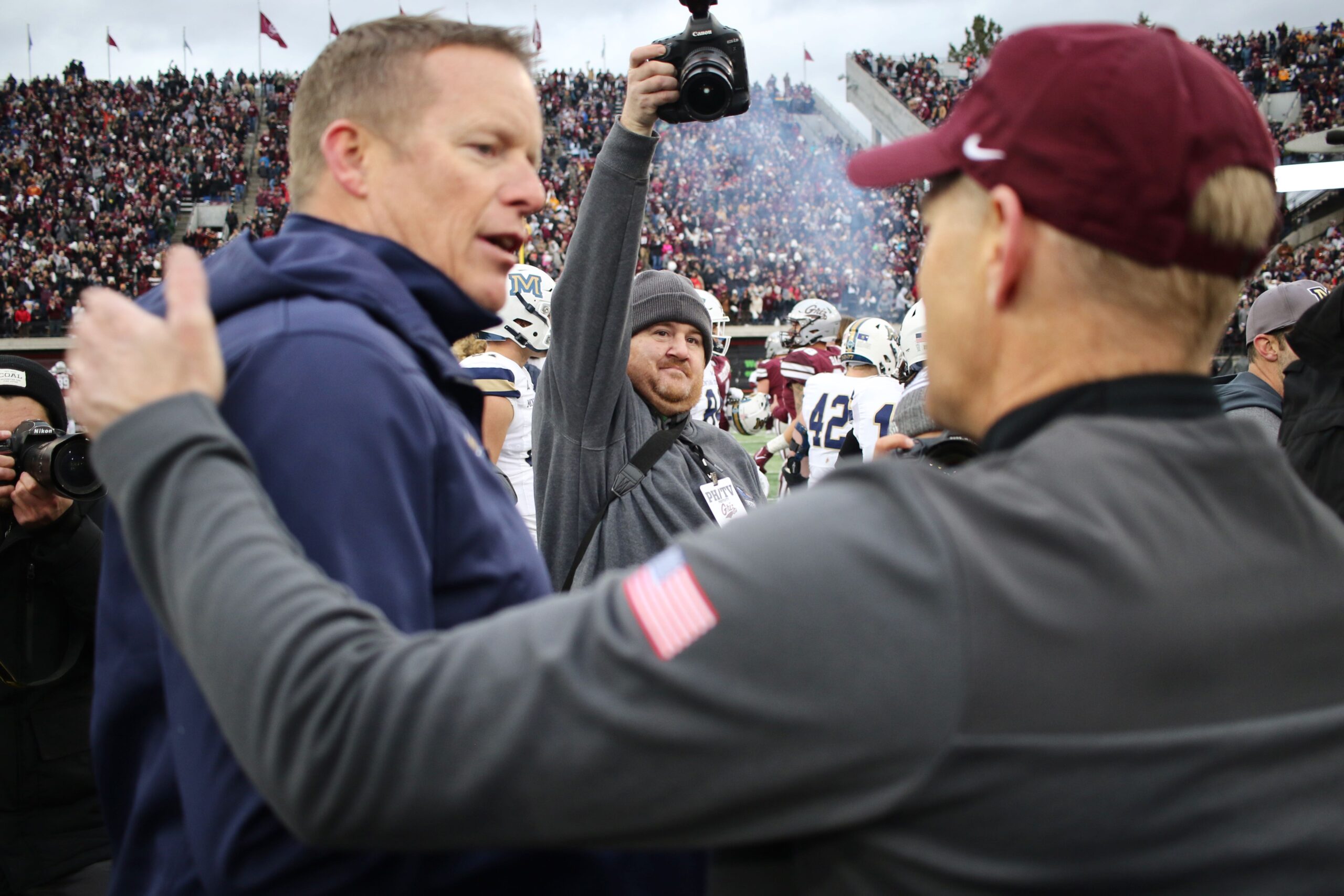
MSU certainly had plenty of success in the Vigen era against UM’s 3-3-5 stack in wins in Bozeman in 2022 (55-21) and last season (34-11). But in MSU’s last two trips to Missoula — a 29-10 Griz win in 2021 and a 37-7 runaway in favor of UM in 2023 — the Bobcat offense found no room to operate as the Griz evaporated the MSU run game, in turn making a team without much passing acumen become a one-dimensional shell of itself.
This version of the Bobcat offense, though, is much more balanced. Lamson, a Stanford transfer, is a leading candidate for Big Sky Conference Offensive Player of the Year honors. Taco Dowler leads a deep group of receivers that has spread the production. A total of 11 different Bobcats have caught touchdowns this season.
“I think their defense presents a lot of challenges but that’s what makes football so fun,” Montana State senior captain center J.T. Reed said. “If everyone played their base defense, football would be pretty boring up front. I’m glad they do this, this and that. It brings a challenge to me and allows us to get better.”
In 2023, Montana rode a veteran, experienced defense and a physical offense to its first Big Sky title since 2009. UM parlayed its 37-7 win over Montana State in Missoula to a playoff run all the way to the national championship game.
That afternoon two years ago in the last rivalry game in Missoula, multiple factors played as to why the Griz piledrove the Bobcats. A big factor was Mellott’s inability to operate in front of a record-setting and raucous crowd. And part of it was MSU’s inability to block Alex Gubner, the Big Sky Defensive Player of the Year that season and a thorn in sides of interior offensive linemen across the conference.
“Last time over there, they had a nose guard over there who was a problem. He was a problem for us that day in 2023,” Vigen said. “That had nothing to do with noise. He was disruptive that day. It’s not that they don’t have good players now. They do. I think allowing them to feed off the energy is what we have to really combat. And that’s about execution on our side.”
Last season in MSU’s 34-11 win, Mellott completed just six passes and threw for just 94 yards. But Missoula native Adam Jones led a Bobcat rushing attack that piled up 326 yards by rushing for 197 yards and two touchdowns himself, including an 88-yard burst that busted the game wide open.
The season before, Mellott completed just four passes for 67 yards. He was able to rush for 108, including a 46-yard spurt. And Julius Davis added 107 rushing yards, including a 30-yard run. But MSU’s run game struggled outside those two gash plays, averaging less than four yards per carry in a lopsided loss.
Vigen said he and the Bobcats will be leaning heavily on Davis and Jones to carry the day against a Griz defense that features 11 players on its two-deep, including six slated starters who will be playing in their first rivalry game against the Bobcats.
“We need Adam and Julius to run hard and break tackles,” Vigen said. “Justin Lamson has to be able to play at a high rate, meaning he just has to take what they give us. He has to communicate out there. It’s the defense, it’s the environment, it’s who are we? We have to be the ones who go execute.”

